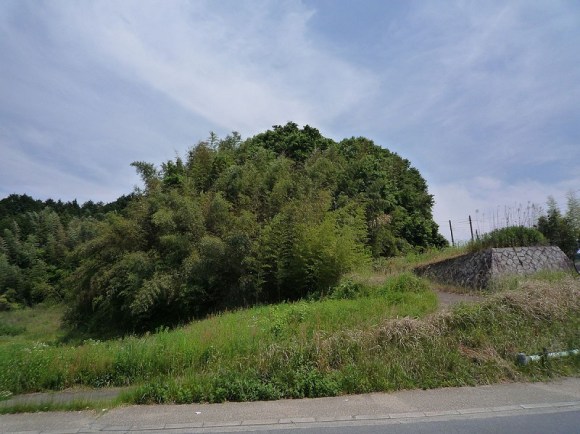
Japan’s kofun are ancient burial mounds that can be found throughout the country in a wide range of sizes and shapes. They’re great sources for learning about the past, covering multiple centuries of Japanese history. Collectively, they offer remarkable glimpses into the life of Japan from the third to the seventh centuries CE.
Kitora Kofun is one of Japan’s smaller kofun, but since its discovery in 1983, it’s proven to be incredibly valuable for historians. With an exhibit focusing on the tomb coming up later this year, some extra work has gone into analyzing the star chart used to decorate one of the walls — and researchers have come to some surprising conclusions about its origin!
Update: As one knowledgeable reader has pointed out, the Nebra Sky Disk is actually much older — dated to around 1,600 BCE. However, it’s not entirely clear if the Nebra Sky Disk is a “star chart” or only a “representation of the cosmos.” We’re looking into this and will provide more information when we have it!
Updated update: We’ve contacted some experts and learned a little more about the Sky Disk. Its and authenticity have been verified by UNESCO, but it is apparently an “astronomical rule” and not a sky chart. As such, it would be accurate to say that the Kitora Kofun sky chart is the oldest in the world — but it’s hardly the oldest representation of the cosmos. Nonetheless, both are fascinating artifacts of our shared global history! We’d also like to thank Dr. Alfred Reichenberger for helping us out!
The original article continues below.
▼ The star chart in question
“開館40周年記念の特別展「キトラ古墳と天の科学」を10月9日から開催。現存最古級の天文図など展示。11月29日まで…”
— ∞音∞ a.k.a. 風*月(𝕗𝕦𝕙𝕘𝕖𝕥𝕤𝕦)𓆈 (@fuhgetsu) July 17, 2015
奈良・飛鳥資料館で特別展開催へ 天文図の新見解も紹介(東京新聞)http://t.co/26Qsd5hZ7h pic.twitter.com/VAKk7wy6RA
Kitora Kofun was likely built in the seventh or eighth century, though it remains unclear who was actually buried in the tomb. Some speculate that it may have been a son of Emperor Tenmu, but while we may never know for sure, the tomb actually presents a fascinating bit of history on the connection between Japan and China at the time.
Of course, envoys and interaction between Japan and China have been widely documented by Chinese sources, stretching back to before Japan even had a written history. And as it turns out, Kitora Kofun’s star chart may actually be a relic of that interaction.
▼ And a pretty relic at that!
キトラ古墳の壁画に、天文図があるなんて、今まで知らんかった!金箔で彩られてるなんて、オサレなお墓だこと( ̄▽ ̄)http://t.co/OVKoTEvaVt pic.twitter.com/Qsu3ce98bS
— ☆渡辺拡朗☆ (@chankoizm) July 16, 2015
In advance of an exhibit featuring Kitora Kofun’s star chart at Nara Prefecture’s Asuka Historical Museum this October, two different researchers sat down and took a close look at the celestial map. Though Kitora Kofun was constructed much later, it seems likely that the chart was made sometime around 400 CE or 80 BCE. Obviously, there’s a big difference between those two dates, but either way, the map was likely made many centuries before the kofun was built.
But even more surprising is the suggestion that it wasn’t even made in Japan!
According to one of the researchers, based on the position of the stars, it’s likely the map originated somewhere around the 34th parallel north latitude. Based on the technology of the time, he also surmised that it was probably created in a major city in China. Regardless of when or where it originated, this is likely the oldest extant star chart in the world. The tomb itself has received a special designation by the Japanese government, like many other kofun.
Despite being well over a thousand years old, the star chart has held up against the ravages of time. We’d definitely encourage everyone to check it out later this year if you have the chance!
▼ A quick video tour of Asuka Historical Musuem
If you are making plans for this autumn, the exhibit will run from October 9 to November 29. Admission will be 270 yen (US$2.15).
Museum information
Asuka Historical Musuem
Address: 601 Okuyama Asukamura Takaichigun Nara-ken 634-0102
〒634-0102 奈良県高市郡明日香村奥山601
Phone number: 0744-54-3561
Website
Sources: Japaaan, Asuka Rekishi Koen, Agency for Cultural Affairs, Daily Matome, Tokyo Shinbun, Wikipedia Japan (Kitora Kofun)
Images: Wikipedia/New Japan

 Exhibition on the 1,500 year-history of traditional Japanese women’s clothing to open in Shibuya
Exhibition on the 1,500 year-history of traditional Japanese women’s clothing to open in Shibuya Happy 2,674 birthday, Japan! Now blow out all those candles!
Happy 2,674 birthday, Japan! Now blow out all those candles! Mysterious mountain village is home to Christ’s grave and an ancient pyramid
Mysterious mountain village is home to Christ’s grave and an ancient pyramid This is a pretty worrying chart for China’s demographic future
This is a pretty worrying chart for China’s demographic future 7 Japanese daily planners to suit every lifestyle, from hostess to otaku!
7 Japanese daily planners to suit every lifestyle, from hostess to otaku! McDonald’s new Happy Meals offer up cute and practical Sanrio lifestyle goods
McDonald’s new Happy Meals offer up cute and practical Sanrio lifestyle goods All-you-can-drink Starbucks and amazing views part of Tokyo’s new 170 meter-high sky lounge
All-you-can-drink Starbucks and amazing views part of Tokyo’s new 170 meter-high sky lounge Super Nintendo World expansion gets delayed for several months at Universal Studios Japan
Super Nintendo World expansion gets delayed for several months at Universal Studios Japan Studio Ghibli glasses cases let anime characters keep an eye on your spectacles
Studio Ghibli glasses cases let anime characters keep an eye on your spectacles Kyoto’s 100 Demons yokai monster parade returns!
Kyoto’s 100 Demons yokai monster parade returns! Beautiful Sailor Moon manhole cover coasters being given out for free by Tokyo tourist center
Beautiful Sailor Moon manhole cover coasters being given out for free by Tokyo tourist center McDonald’s Japan’s new kalbi koshihikari rice burger and its friends only come out after sundown
McDonald’s Japan’s new kalbi koshihikari rice burger and its friends only come out after sundown Mister Donut ready to make hojicha dreams come true in latest collab with Kyoto tea merchant
Mister Donut ready to make hojicha dreams come true in latest collab with Kyoto tea merchant There’s a park inside Japan where you can also see Japan inside the park
There’s a park inside Japan where you can also see Japan inside the park The oldest tunnel in Japan is believed to be haunted, and strange things happen when we go there
The oldest tunnel in Japan is believed to be haunted, and strange things happen when we go there Disney princesses get official manga makeovers for Manga Princess Cafe opening in Tokyo
Disney princesses get official manga makeovers for Manga Princess Cafe opening in Tokyo More foreign tourists than ever before in history visited Japan last month
More foreign tourists than ever before in history visited Japan last month Starbucks reopens at Shibuya Scramble Crossing with new look and design concept
Starbucks reopens at Shibuya Scramble Crossing with new look and design concept Beautiful new Final Fantasy T-shirt collection on the way from Uniqlo【Photos】
Beautiful new Final Fantasy T-shirt collection on the way from Uniqlo【Photos】 Is the new Shinkansen Train Desk ticket worth it?
Is the new Shinkansen Train Desk ticket worth it? Foreign English teachers in Japan pick their favorite Japanese-language phrases【Survey】
Foreign English teachers in Japan pick their favorite Japanese-language phrases【Survey】 Japanese convenience store packs a whole bento into an onigiri rice ball
Japanese convenience store packs a whole bento into an onigiri rice ball We try out “Chan Ramen”, an underground type of ramen popular in the ramen community
We try out “Chan Ramen”, an underground type of ramen popular in the ramen community Studio Ghibli releases Kiki’s Delivery Service chocolate cake pouches in Japan
Studio Ghibli releases Kiki’s Delivery Service chocolate cake pouches in Japan Japan’s bone-breaking and record-breaking roller coaster is permanently shutting down
Japan’s bone-breaking and record-breaking roller coaster is permanently shutting down New definition of “Japanese whiskey” goes into effect to prevent fakes from fooling overseas buyers
New definition of “Japanese whiskey” goes into effect to prevent fakes from fooling overseas buyers Our Japanese reporter visits Costco in the U.S., finds super American and very Japanese things
Our Japanese reporter visits Costco in the U.S., finds super American and very Japanese things Studio Ghibli unveils Mother’s Day gift set that captures the love in My Neighbour Totoro
Studio Ghibli unveils Mother’s Day gift set that captures the love in My Neighbour Totoro Foreign passenger shoves conductor on one of the last full runs for Japan’s Thunderbird train
Foreign passenger shoves conductor on one of the last full runs for Japan’s Thunderbird train Domino’s Japan now sells…pizza ears?
Domino’s Japan now sells…pizza ears? New Japanese KitKat flavour stars Sanrio characters, including Hello Kitty
New Japanese KitKat flavour stars Sanrio characters, including Hello Kitty Kyoto creates new for-tourist buses to address overtourism with higher prices, faster rides
Kyoto creates new for-tourist buses to address overtourism with higher prices, faster rides Sales of Japan’s most convenient train ticket/shopping payment cards suspended indefinitely
Sales of Japan’s most convenient train ticket/shopping payment cards suspended indefinitely Sold-out Studio Ghibli desktop humidifiers are back so Totoro can help you through the dry season
Sold-out Studio Ghibli desktop humidifiers are back so Totoro can help you through the dry season Japanese government to make first change to romanization spelling rules since the 1950s
Japanese government to make first change to romanization spelling rules since the 1950s Ghibli founders Toshio Suzuki and Hayao Miyazaki contribute to Japanese whisky Totoro label design
Ghibli founders Toshio Suzuki and Hayao Miyazaki contribute to Japanese whisky Totoro label design Doraemon found buried at sea as scene from 1993 anime becomes real life【Photos】
Doraemon found buried at sea as scene from 1993 anime becomes real life【Photos】 Tokyo’s most famous Starbucks is closed
Tokyo’s most famous Starbucks is closed One Piece characters’ nationalities revealed, but fans have mixed opinions
One Piece characters’ nationalities revealed, but fans have mixed opinions We asked a Uniqlo employee what four things we should buy and their suggestions didn’t disappoint
We asked a Uniqlo employee what four things we should buy and their suggestions didn’t disappoint Princesses, fruits, and blacksmiths: Study reveals the 30 most unusual family names in Japan
Princesses, fruits, and blacksmiths: Study reveals the 30 most unusual family names in Japan Don’t know which sake to drink? These handy flavor charts help you pick by region of Japan
Don’t know which sake to drink? These handy flavor charts help you pick by region of Japan Toilet slides and turd hats: welcome to Tokyo’s crappiest exhibition
Toilet slides and turd hats: welcome to Tokyo’s crappiest exhibition Cola-flavored mochi sweets are half Japanese tradition, half jiggly Pop Rock
Cola-flavored mochi sweets are half Japanese tradition, half jiggly Pop Rock Anime Your Name passes Princess Mononoke on all-time Japanese box office list, is now at number 3
Anime Your Name passes Princess Mononoke on all-time Japanese box office list, is now at number 3 Travel through time with these old maps from the Zenrin Virtual Museum
Travel through time with these old maps from the Zenrin Virtual Museum Tech journalist predicts Japan’s Pokémon Go release date
Tech journalist predicts Japan’s Pokémon Go release date Believe in the nap of the cards with the crazy Yu-Gi-Oh! Duel Disk Nap Pillow【Photos】
Believe in the nap of the cards with the crazy Yu-Gi-Oh! Duel Disk Nap Pillow【Photos】 Japan’s legendary Brother Katana might not be brothers after all? Investigating the mystery【Pics】
Japan’s legendary Brother Katana might not be brothers after all? Investigating the mystery【Pics】 “Draw Asuka!” — A.I.-created doodles are adorable, but aren’t quite there yet…
“Draw Asuka!” — A.I.-created doodles are adorable, but aren’t quite there yet… New survey shows Japan to be deeply divided among blue and red prefectures
New survey shows Japan to be deeply divided among blue and red prefectures Weathering with You anime exhibition coming to Tokyo with special cafe menu items
Weathering with You anime exhibition coming to Tokyo with special cafe menu items Japanese net mourns 2020 hiatus of mega-idols Arashi, group explains reasons for the decision
Japanese net mourns 2020 hiatus of mega-idols Arashi, group explains reasons for the decision Animal-cracker-themed Tabekko Dobutsu Land saves the day for our reporter
Animal-cracker-themed Tabekko Dobutsu Land saves the day for our reporter Japanese hotel that hosted last four emperors offering rooms for fraction of their regular price
Japanese hotel that hosted last four emperors offering rooms for fraction of their regular price Real life android looks almost too real
Real life android looks almost too real
Leave a Reply